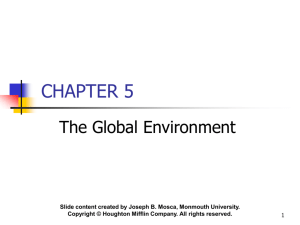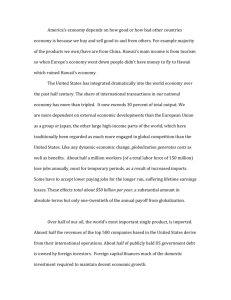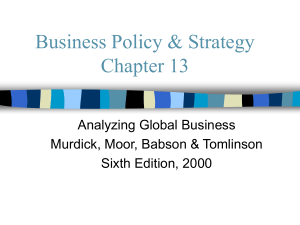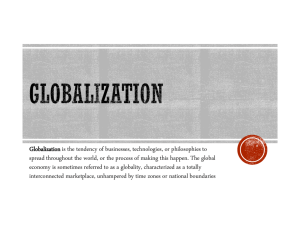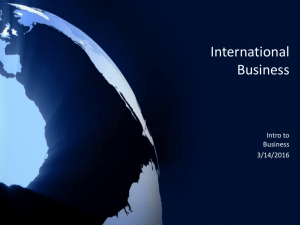Protectionism
advertisement
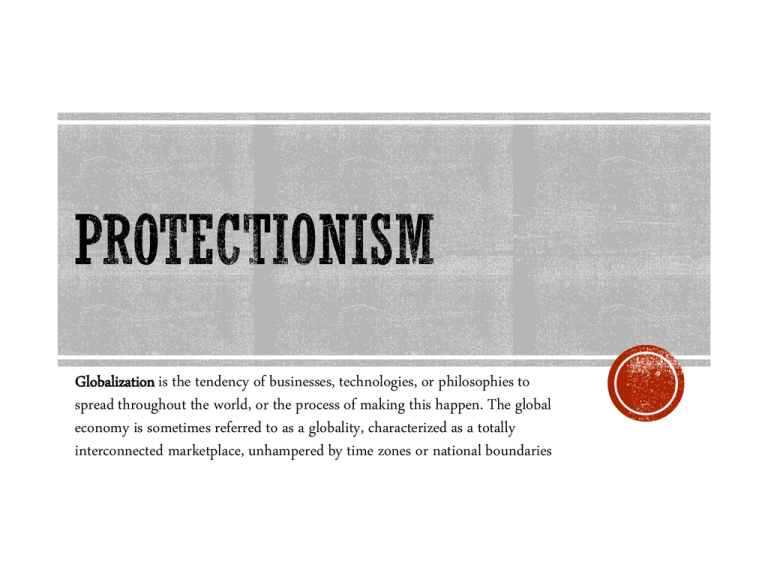
Globalization is the tendency of businesses, technologies, or philosophies to spread throughout the world, or the process of making this happen. The global economy is sometimes referred to as a globality, characterized as a totally interconnected marketplace, unhampered by time zones or national boundaries The relationship between a nation’s imports and its exports is called its balance of trade Investopedia video clip When a nation exports more than it imports it has a positive trade balance When a nation imports more than it exports it has a negative trade balance EOC study guide Globalization #11 & 12 Come up with a list of the top five countries we import goods from….. Come up with a list of the top five countries we export to…. Rank Country Imports Percent of Total Imports --- Total, All Countries 2,084.9 Billion 100.0% --- Total, Top 15 Countries 1,586.6 Billion 76.1% 402.9 19.3% 305.4 14.6% 258.3 12.4% 127.3 6.1% 105.1 5.0% 1 2 3 4 5 China Canada Mexico Japan Germany Rank Country Percent of Total Exports Exports --- Total, All Countries 1,448.2 Billion 100.0% --- Total, Top 15 Countries 1,033.6 Billion 71.4% 277.0 19.1% 208.2 14.4% 108.9 7.5% 59.9 4.1% 44.0 3.0% 43.8 3.0% 1 2 3 4 5 6 Canada Mexico China Japan United Kingdom Germany Began in 1970s when OPEC dramatically raised the price of oil Imports of foreign oil continue to account for the large US trade deficit Americans love of imported goods also plays a part Lower labor and production costs in other countries contribute Protectionist policies in other countries contribute EOC study guide Globalization #3 Protectionism is the use of trade barriers to protect a nation's industries from foreign competition they can also be used to “punish” a foreign government Tariff—a tax on imported goods EOC study guide Globalization #3 b Export subsidies—a Government payment to firms in its own country allowing the firms to sell their goods at lower prices Quota—a limit on the amount of a good that can be imported Why is their corn in your coke? EOC study guide Globalization #3c But, How Do I Benefit From Trade? Determine where the shirt you are wearing was produced. (Look for the "Made in _______" tag.) 1. How do you benefit from being able to buy goods made in other countries? 2. Would you favor a policy that would raise the price on T-shirts and reduce the amount available? Trade barriers increase prices for foreign goods This is bad for Consumers This is good for Domestic producers of that good Sanctions are domestic penalties applied by one country (or group of countries) on another country may include trade barriers and restrictions on financial transactions EOC study guide Globalization #4a Embargoes are the partial or complete prohibition of commerce and trade with a particular country. As of May 2013, the United States has sanctions against: Burma, since 1997 Cuba, since 1962 Iran, since 1979 Libya, since 2011 EOC study guide North Korea, since 1950 Globalization #4b Sudan, since 2002 Syria, since 1986 Tariff In 1979, a group of radical students in Tehran seized the American embassy and took the people inside hostage. President Carter issued Executive Order 12170 freezing about $12 billion in Iranian assets, including Sanction Quota Tariff Arms Embargo Export subsidy How could the US reduce its trade deficit? Tariffs, quotas, and other protectionist measures that encourage consumers to buy American rather than imported goods After WWII representatives from 44 countries created a fixed exchange-rate system for the US and much of western Europe Because the US had the strongest economy with the most stable currency, the US dollar was at the center of the new system Beginning in 1945, the conference participants agreed to fix their currencies to the US dollar The International Monetary Fund (IMF) was created to make the system work EOC study guide Globalization #7 continued The foreign currency exchange rate is the value of a foreign nation’s currency in terms of the home nation’s currency The dollar price you would pay to buy a euro is called the exchange rate Suppose the exchange rate is $1 =₡0.80, then for every dollar you will get 0.8 Euros in exchange An increase in the value of a currency is called appreciation A decrease in the value of a currency is called depreciation EOC study guide Globalization #13 Outsourcing is when a company obtains goods or services from a foreign supplier who can provide it cheaper Examples: Dell buying some of its computer components from another manufacturer in order to save on production costs. A business outsourcing book-keeping duties to an independent accounting firm, because its cheaper than retaining an in-house accountant. Investopedia video clip EOC study guide Globalization #14

